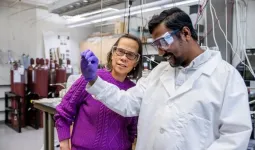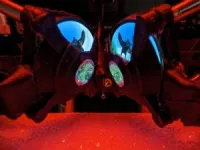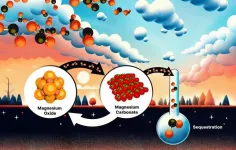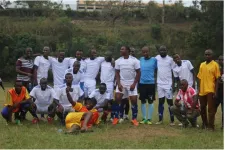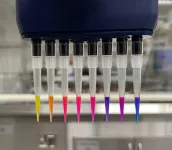(Press-News.org) The most durable, heat-resistant materials ever made could be hiding in plain sight.
The U.S. Department of Defense wants to know if minerals and rocks found on Earth and in space hold the secrets of next-generation high-temperature materials. To find out, the DOD awarded $6.25 million through its Multidisciplinary University Research Initiative, or MURI, to a team from the University of Virginia and Arizona State University. The group is led by UVA’s Elizabeth J. Opila, the Rolls-Royce Commonwealth Professor and chair of the Department of Materials Science and Engineering.
The highly competitive MURI funds fundamental scientific research the DOD hopes will lead to breakthroughs in its areas of interest through collective insights from multiple disciplines.
Reading the Rocks
“It’s a boom time for high-temperature materials because of needs in energy production, hypersonics and new things like additive manufacturing coming on in the field,” Opila said. “[People are] exploring new compositional spaces where you’re mixing different elements in different ways. On top of that we’re thinking about this geologically and planetary-inspired materials, which is lots of fun.”
Minerals and rocks are complex compared to the compounds materials scientists usually work with, Opila said, and that’s why the project’s potential is exciting.
“The geologists are really focused on how the earth formed and where we can find these different substances,” Opila said. “We want to take that knowledge and bring it into the application space.”
Selecting for specific physical properties, the researchers will copy Mother Nature’s use of mineral composition, temperature, pressure, and the rapid changes in these forces, to make their synthetic materials. The goal is to dramatically expand, and document for others, the means and ingredients from which high-temperature materials can be processed to surpass anything yet conjured by people or nature.
On the Hunt for Refractory Materials
Addressing needs for ever-better refractory materials — those which resist weakening, melting or decomposing under intense heat or corrosive conditions, the Army Research Office called for proposals on Emergent Refractory Behaviors in Earth and Extraterrestrial Materials. Amongst several objectives, Opila’s team will design, make, test and describe a host of new materials meant to outperform current ceramics, alloys and coatings used in intensely hot environments — for example, a 3,000-degree jet engine.
Opila is a former NASA scientist and innovator in heat- and corrosion-resistant materials. Her collaborators are experts in geology, computational modeling and materials science from UVA’s School of Engineering and Applied Science and ASU’s schools of Engineering of Matter, Transport and Energy; Molecular Sciences; and Earth and Space Exploration.
Fast-Tracking Discovery
Opila’s co-principal investigators from UVA’s Engineering are Patrick E. Hopkins, the Whitney Stone Professor of Engineering in mechanical and aerospace engineering, and assistant professor of materials science and engineering Bi-Cheng Zhou.
Hopkins’ ExSiTE Lab specializes in laser-based techniques for measuring thermal properties. His lab will be instrumental in characterizing the materials the team comes up with.
Zhou is a computational modeler known for inventing variations on the CALPHAD method to expand its capabilities. He and another computational modeling specialist, ASU assistant professor in materials science and engineering Qijun Hong, will use their respective expertise to fast-track discovery of promising “recipes” for experimental labs to try at both schools.
The ASU labs are run by Alexandra Navrotsky, a renowned interdisciplinary expert in thermodynamics and director of the Navrotsky Eyring Center for Materials of the Universe, and Hongwu Xu, a mineralogist and materials chemist and professor in ASU’s schools of Molecular Sciences and Earth and Space Exploration.
The teams will make and analyze prospective recipes — often exchanging samples for testing, Opila said, with her lab bringing extreme heat, while the ASU labs apply intense pressure as well as high-temperature testing.
Clipping Coupons
Synthesis of test samples typically starts with an element in powder form, said UVA Ph.D. student Pádraigín Stack, which is chemically altered to isolate a target material, or a component of a target.
The new composition, which has been diluted, heated and dried back to a powder, is then sintered, a process applying enough heat and pressure to form a dense puck of material. Thin slices from the puck, called coupons, provide the samples researchers will subject to various tests — for example, exposing it to steam at high velocities in Opila’s lab or, at ASU, applying geological-like pressures with a diamond anvil.
In addition to these traditional synthesis methods, the team will try approaches inspired by planetary or geological phenomena, such as hydrothermal synthesis, which occurs in heated water at elevated pressures. Since water is abundant in Earth’s hot, pressurized interior, hydrothermal processes are associated with, for example, the formation of minerals containing rare earth elements — critical components for many renewable energy applications.
In the lab, hydrothermal synthesis involves forming crystals in a hot water-based solution in a closed vessel such that gaseous molecules moving atop the liquid exert high vapor pressure within the system.
The Dilemma of Rare Earth Elements
One focus of the MURI project is utilizing rare earth elements. Many rare earth elements are already used in conventional high-temperature materials, such as environmental barrier coatings in aviation and hypersonic flight, as well as batteries, LED devices and other increasingly in-demand products — but at a steep cost. While not actually rare, separating the elements from soil and rock requires dozens of steps, most of them polluting.
“All these rare earth oxides that we’re going to use are in minerals right now,” Opila said. “Somebody mines them and then they have to separate them all. For example, ytterbium and lutetium are neighbors on the periodic table. They are so chemically similar, it takes 66 steps involving many chemicals resulting in nasty waste products.”
The separation problem led Opila to ask a question at the heart of another project she and her students are working on that’s related to the MURI: “What if you take a mineral made of elements you want straight out of the ground but not separate them, just clean it up a bit and make your material from that?”
They’re experimenting with xenotime, a common mineral, to improve environmental barrier coatings, or EBCs, which protect jet engine parts from hazards like high-velocity steam and desert sand. Ingested sand can melt into glass and react with the underlying alloy if it infiltrates the coating.
“We know certain minerals are stable because we can find them in the ground,” Stack said. “You don’t find metallic iron in the ground, you find iron oxide because iron oxide is what’s stable. Let’s explore why something is stable, or if it has other useful properties, and use that knowledge to make something better.”
END
Finding the most heat-resistant substances ever made
UVA Engineering secures DOD MURI award to advance high-temperature materials
2023-12-08
ELSE PRESS RELEASES FROM THIS DATE:
Time-tested magnesium oxide: Unveiling CO2 absorption dynamics
2023-12-08
Magnesium oxide is a promising material for capturing carbon dioxide directly from the atmosphere and injecting it deep underground to limit the effects of climate change. But making the method economical will require discovering the speed at which carbon dioxide is absorbed and how environmental conditions affect the chemical reactions involved.
Scientists at the Department of Energy’s Oak Ridge National Laboratory analyzed a set of magnesium oxide crystal samples exposed to the atmosphere for decades, and another for days to months, to gauge the reaction rates. They found that carbon ...
Engaging heterosexual men more effectively could slash HIV infections in Uganda
2023-12-08
A study looking at 15 years of HIV transmission and suppression in Uganda reveals how closing gender gaps in treatment could slash infection rates.
Providing more heterosexual men with easy access to HIV treatment and care could help to suppress the virus and rapidly cut transmission to their female partners, shows a new study published in Nature Microbiology.
The research, led by scientists from Imperial College London and the Rakai Health Sciences Program in Uganda, analysed 15 years of data from 2003-2018, during which the US President’s Emergency Plan For AIDS ...
A fork in the rhod: Janelia researchers unveil comprehensive collection of rhodamine-based fluorescent dyes
2023-12-08
When Senior Scientist Jonathan Grimm came to Janelia 13 years ago, he didn’t know much about fluorescence or fluorescent dyes. But as an organic chemist who had been working in drug discovery at Merck, he certainly knew a thing or two about medicinal chemistry.
On a whim, Grimm and Janelia Senior Group Leader Luke Lavis decided to try using a mainstay medicinal chemistry reaction Grimm had picked up in the pharmaceutical industry to improve centuries-old dye chemistry. They thought this approach could allow access to completely new, previously inaccessible rhodamines – molecules Lavis had been working to make brighter and longer-lasting so they could be ...
The Gerontological Society of America congratulates new 2023 awardees
2023-12-08
The Gerontological Society of America (GSA) — the country’s largest interdisciplinary organization devoted to the field of aging — is proud to acknowledge the work of 34 outstanding individuals through its prestigious awards program.
GSA salutes outstanding research, recognizes distinguished leadership in teaching and service, and fosters new ideas through a host of awards. Nominated by their peers, the recipients’ achievements serve as milestones in the history and development of ...
Texas A&M Institute part of national effort to harness nuclear laser fusion for limitless energy
2023-12-08
Nuclear fusion, the process that powers the sun, is the ultimate source of energy for all life on Earth. On the sun, deuterium and tritium nuclei combine to produce an alpha particle (the nucleus of a helium atom) and a neutron. The dream is to do the same down here, on Earth, in a controlled manner.
It’s for good reason that harnessing fusion energy is one of the greatest scientific and technological challenges of the 21st century. Fusion requires the fuel to be heated to more than 100 million degrees (10 times hotter than the core of the sun). Practical fusion energy also requires that the burning fuel is kept at these hot temperatures long enough so that energy ...
How health system hesitancies contributed to COVID risks
2023-12-08
More than 1.2 million people have died in the United States during the COVID-19 pandemic to date, more documented deaths than any other nation on Earth.
While many have attributed the high death toll on widespread personal hesitancy to wear masks, avoid crowded places or receive vaccines once they were developed, there were several “system hesitancies” that contributed to the tragic outcomes that need addressing, according to an analysis published Dec. 6, 2023, in Health Affairs Forefront.
The analysis ...
Stand Up to Cancer names Julian Adams, Ph.D., President and CEO
2023-12-08
LOS ANGELES – December 8, 2023 – Stand Up To Cancer® (SU2C) today announced the appointment of Julian Adams, Ph.D., as president and chief executive officer, which will be effective on January 1, 2024. Adams had previously served on SU2C’s Scientific Advisory Committee since 2008, and officially joined SU2C in July 2023 in the newly created position of chief science officer. He succeeds Russell Chew, who joins SU2C’s Board of Directors.
Adams is a longtime oncology researcher and pharmaceutical industry senior executive specializing in drug discovery and development in cancer. With this appointment, Adams assumes management responsibility for SU2C’s overall ...
Immersive VR goggles for mice unlock new potential for brain science
2023-12-08
Northwestern University researchers have developed new virtual reality (VR) goggles for mice.
Besides just being cute, these miniature goggles provide more immersive experiences for mice living in laboratory settings. By more faithfully simulating natural environments, the researchers can more accurately and precisely study the neural circuitry that underlies behavior.
Compared to current state-of-the-art systems, which simply surround mice with computer or projection screens, the new goggles provide a leap in advancement. In current systems, mice can still see the lab environment peeking out from behind the screens, and the screens’ ...
Racial and ethnic differences in hospice use among Medicaid-only and dual-eligible decedents
2023-12-08
About The Study: In this study, in both Medicaid only and dual-eligible populations, Hispanic and non-Hispanic Black individuals had the lowest odds of receiving hospice, and Hispanic individuals had the highest odds of a short hospice stay. Knowledge about, access to, and acceptance of hospice may be lacking for these low-income individuals. Further research is needed to understand barriers to and facilitators of hospice use for people with nursing facility stays.
Authors: Julie ...
County–level variation in preterm birth rates
2023-12-08
About The Study: In this analysis of U.S. county-level preterm and early preterm birth rates, substantial geographic disparities were observed, which were associated with place-based social disadvantage. Stability in aggregated rates of preterm birth at the national level masked increases in nearly 1 in 6 counties between 2007 and 2019.
Authors: Sadiya S. Khan, M.D.,M.S., of the Northwestern University Feinberg School of Medicine in Chicago, is the corresponding author.
To access the embargoed study: Visit our For The Media website at ...
LAST 30 PRESS RELEASES:
Autistic and non-autistic faces may “speak a different language” when expressing emotion
No clear evidence that cannabis-based medicines relieve chronic nerve pain
Pioneering second-order nonlinear vibrational nanoscopy for interfacial molecular systems beyond the diffraction limit
Bottleneck in hydrogen distribution jeopardises billions in clean energy
Lung cancer death rates among women in Europe are finally levelling off
Scientists trace microplastics in fertilizer from fields to the beach
The Lancet Obstetrics, Gynecology, & Women’s Health: Taking paracetamol during pregnancy does not increase risk of autism, ADHD or intellectual disabilities, confirms new gold-standard evidence review
Taking paracetamol during pregnancy does not increase risk of autism, ADHD or intellectual disabilities
Harm reduction vending machines in New York State expand access to overdose treatment and drug test strips, UB studies confirm
University of Phoenix releases white paper on Credit for Prior Learning as a catalyst for internal mobility and retention
Canada losing track of salmon health as climate and industrial threats mount
Molecular sieve-confined Pt-FeOx catalysts achieve highly efficient reversible hydrogen cycle of methylcyclohexane-toluene
Investment in farm productivity tools key to reducing greenhouse gas
New review highlights electrochemical pathways to recover uranium from wastewater and seawater
Hidden pollutants in shale gas development raise environmental concerns, new review finds
Discarded cigarette butts transformed into high performance energy storage materials
Researchers highlight role of alternative RNA splicing in schizophrenia
NTU Singapore scientists find new way to disarm antibiotic-resistant bacteria and restore healing in chronic wounds
Research suggests nationwide racial bias in media reporting on gun violence
Revealing the cell’s nanocourier at work
Health impacts of nursing home staffing
Public views about opioid overdose and people with opioid use disorder
Age-related changes in sperm DNA may play a role in autism risk
Ambitious model fails to explain near-death experiences, experts say
Multifaceted effects of inward foreign direct investment on new venture creation
Exploring mutations that spontaneously switch on a key brain cell receptor
Two-step genome editing enables the creation of full-length humanized mouse models
Pusan National University researchers develop light-activated tissue adhesive patch for rapid, watertight neurosurgical sealing
Study finds so-called super agers tend to have at least two key genetic advantages
Brain stimulation device cleared for ADHD in the US is overall safe but ineffective
[Press-News.org] Finding the most heat-resistant substances ever madeUVA Engineering secures DOD MURI award to advance high-temperature materials
